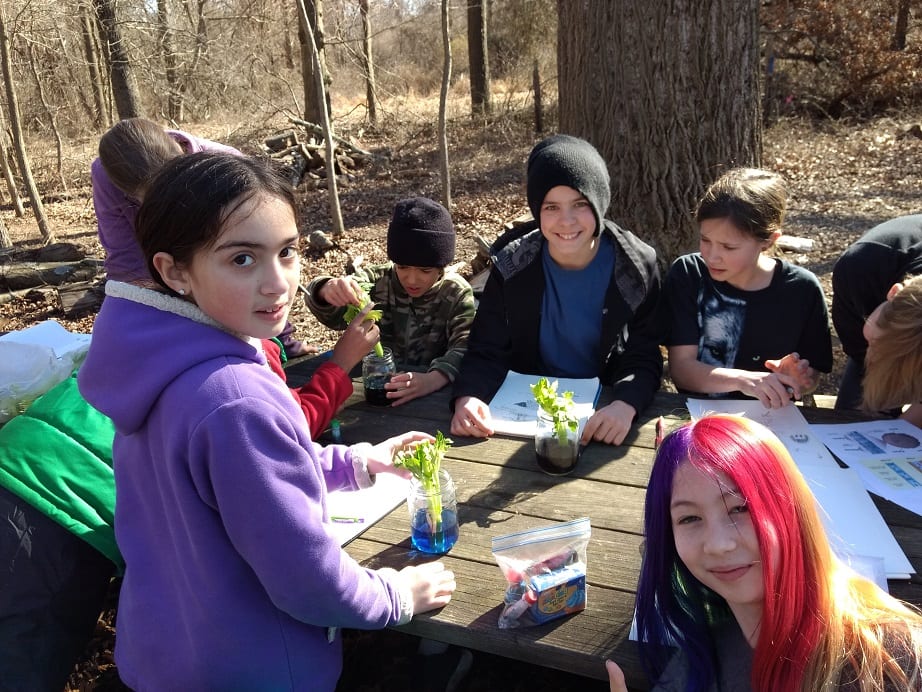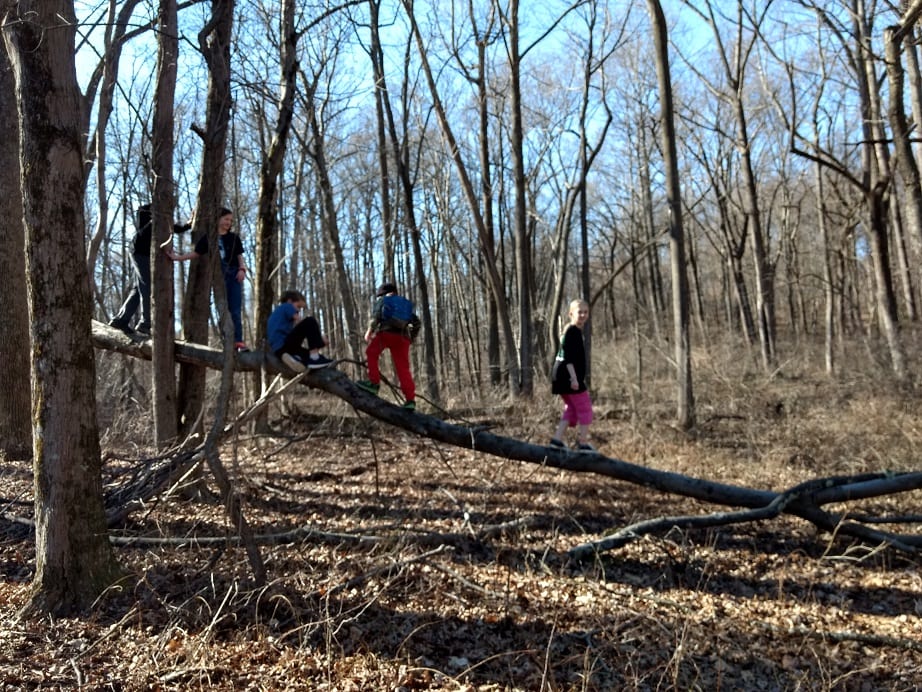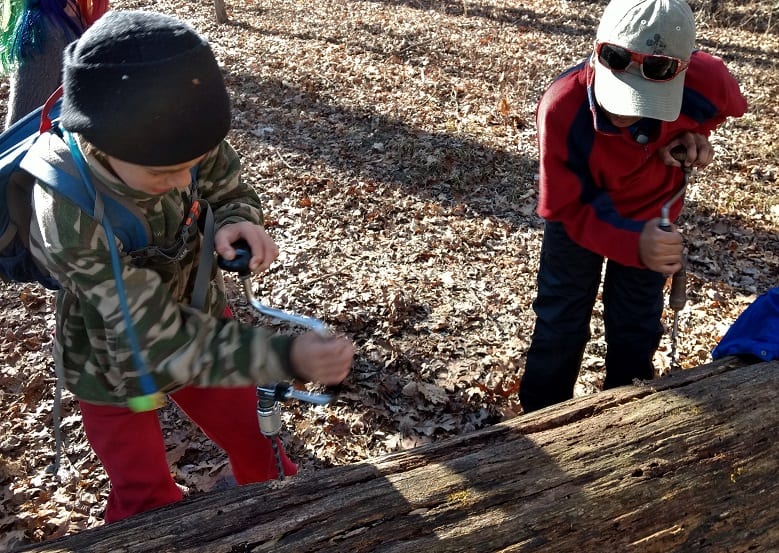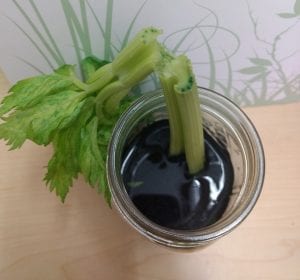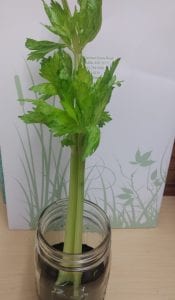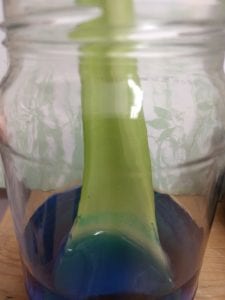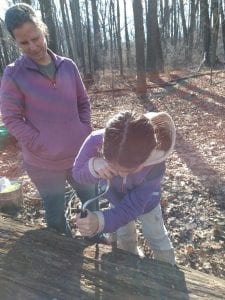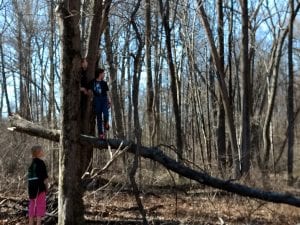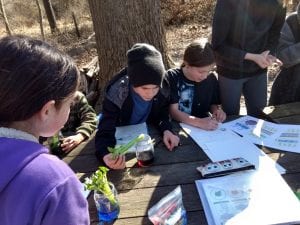Welcome back to Biomimicry! In this homeschool class we learn about how plants and animals have inspired technologies and ideas that help people live better and sometimes even more sustainable lives. We welcomed two new students to our class and started the day by going around and sharing our favorite animal, one thing love to do outside and something we were excited to do this spring. Some of the activities we’re excited for this spring are climbing trees, hiking and exploring Irvine and building campfires. We opened our journals and as a group brainstormed our guidelines that we want to follow in our class. Everyone wrote them down in their journal. Since it was nearing the end of February it was a perfect time to talk about Maple Sugaring. Here at Irvine we have a number of trees tapped with buckets ready to collect sap and we have our own sugar house down at the barn where an evaporator is set up and other fun activities to help us learn more about the maple sugaring process. Talking about Maple Sugaring is also a great way to learn more about the inner workings of trees and how they move water and sugars around in their bodies.
We reviewed a few of the ways in Fall that we learned about how water moves by the forces of Capillary Action by doing an experiment with colored water and paper towels and also an experiment with coffee filters and plants to see the different pigments of the leaves. Today, we used celery to learn more about the xylem and phloem of plants and how that plays a part in Maple Sugaring. First, we drew a picture of a basic tree in our journals. Looking around at the trees around us we brainstormed some of the things that trees need to survive, like water, nutrients, sunlight and air (CO2) specifically. How do trees get water into their bodies? They use their roots but how does that water then get up to the top of the tree? Well most of the tree’s trunk is non living tissue that was alive but as the tree grew it left behind strong hard wood to keep the trunk strong. Inside that wood are tubes that have since dried up but remain a passageway for water and nutrients, just like pipes in a house. The water travels UP the Xylem and feeds the leaves and the rest of the tree. On our tree picture we drew an arrow up our tree and labeled it “Xylem.” Well what happens in leaves? Leaves make sugar in their leaves with the help of water, CO2 and sunlight. That sugar is food for the entire tree, so how does it get down to the roots? Right under the bark is a living layer of tissue called the Cambium which contails the Phloem. The Phloem acts more like a sponge and water moves DOWN the phloem (but it can also move up!). On our picture we drew a down arrow and labeled it “Phloem.” Next we added any other labels we thought were helpful like drawing a sun and labeling sunlight and CO2 next to the leaves. Here is a simple but well explained link to the Xylem and Phloem including a diagram:
http://ib.bioninja.com.au/higher-level/topic-9-plant-biology/untitled/xylem-versus-phloem.html
That doesn’t really explain how the water moves up though. The tubes aren’t alive so they can’t pump the water, so how does it work? Well, water evaporates out of the leaves (it’s called transpiration). Imagine the leaves breathing. When water leaves the leaf it must be replaced and through the power of Capillary Action, that water is replaced and more water is drawn up the tree like a straw. Okay, so what about trees in winter, how does sap move around if there aren’t any leaves? The magic behind Maple Sugaring is the freezing temperatures at night and the warming temperatures during the day. At night, the water freezes in the tree, shrinking the sizes of the gas and air bubbles reducing the pressure in the tree, like deflating a balloon. During the day, the water melts, the gas is released and the pressure increases, like blowing up a balloon. The water needs to escape and it does this normally through broken branches and small holes unless humans have come along and tapped the tree. Here is a great website that explains Maple Sugaring:
http://blog-yard-garden-news.extension.umn.edu/2009/04/the-mystery-of-maple-sap-flow.html
We hiked out on the trail, after putting together our celery experiment that I would check the next day since it has to sit over night, and found our first tapped Red Maple tree and bucket. We checked inside and found a good amount of bugs but despite the bugs taste tested the water. It mostly tastes like water since it is so diluted but it does have a hint of flavor to it. James described it as tasting “clear and cold and it tasted how plants smell.” Great description! We enjoyed snack at the gazebo and read a Native American tale about maple sap called “Manabozho and the Maple Trees” from the book Keepers of the Earth. After filling up we headed down to the boardwalk and warmed up our climbing skills and practiced using a maple sugaring drill. This drill is the same drill that can be used to drill into trees to tap. Trees need to be at least 10 inches in diameter and you drill the length of the spyle. We practiced on downed logs and the spyle fit in perfectly.
We finished the day by playing a few rounds of Camouflage in the woods, which is made extra difficult by the lack of leaves on the trees and bushes. We then joined the other homeschool groups at the barn for some free play and exploration of the “sugar shack.” We looked briefly at the evaporator that boils down the sap and the materials around the fire that were used by settlers and Native Americans to make maple syrup and candies. Lastly, we saw the 40 one gallon jugs hanging at the barn and got a great visual for how much sap it takes to make just 1 gallon of syrup (or less). It was a great first day!
Next week we’ll review our celery experiment and review Biomimicry and learn more about animal communication and do some fun experiments!
